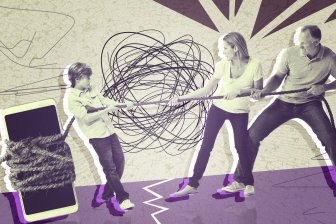A few years ago, I was talking to a high school student about music. “What do you listen to your music on?” I asked.
She pointed at her laptop. “That,” she replied. “Through the speakers.”
I was aghast. “You that’s how you hear all your favourite songs? Through laptop speakers?”
She shrugged. “It’s good enough,” she said.
Good enough? What?
If you’re of a certain vintage (i.e. you grew up before the internet and MP3s,) you may remember spending an insane amount of after-tax dollars on a stereo system, hoping to build the biggest, baddest, loudest, clearest, most accurate audio experience within your budget. At one point, I had something in my bedroom capable of acting as a PA for a Black Sabbath set at Glastonbury. The stereo in my car was only slightly less powerful, but still capable of filling a decent-sized arena.
This kind of audio culture (and, okay, fetishization) was everywhere. All my friends — this was almost exclusively a dude thing — all dove into the deep end. We bought what we could afford and then spent many an afternoon in stores auditioning super-high-end speakers and other gear. It cost nothing and we spent the entire time listening to our favourite recordings played back in their best possible glory.
That all came crashing down with the rise of the MP3. Encoders crushed files to one-tenth of their normal size, making it possible to transmit them down old copper telephone wires. MP3s were also seen as the solution to a storage problem on PCs. Computer hard drives were pitifully small by today’s standards, so ripping an entire CD in its original .wav format was a non-starter. One of my old 1 GB HDDs would have barely held one CD. Instead of just storing a couple of dozen songs in .wav, on such a drive, you could store thousands of MP3s.
We marvelled at the magic of this technology. The selection! The portability! The libraries and playlists we built! The file-sharing! Yes, the sound wasn’t quite as good as our old records and CDs, but the tradeoff between convenience and audio quality was worth it. We were okay with substandard audio. And outside of a niche community of audiophiles, that’s where we’ve been stuck for a couple of decades.
In fact, today’s music sounds worse than it did in the 1970s or even the 1960s. Too many new CDs feature music that’s compressed in a misguided attempt to make it appear louder, squishing out all the dynamic range. The Red Hot Chili Peppers and Metallica (especially the St. Anger album) are among the worst offenders. When those songs are played over the radio, even more compression is added. If you rip those songs to MP3 — well, it’s like sticking a grape can in a hydraulic press. And yes, the majority of radio stations do play digital files, even MP3s with criminally low (below 320 kpbs) bitrates.
Meanwhile, the audio industry is desperate for a long upgrade cycle when consumers will move from compressed music and the devices that play them to something much better such as Hi-Res Audio and other “lossless” (i.e. no compression) digital formats. Such a movement would send a multi-billion-dollar ripple through almost all areas of consumer electronics.
Oh, they’ve tried. Anyone remember SACDs or HDCD? Both were optical discs with twice the resolution of audio CDs and were capable of delivering music with astounding clarity. They still exist, but you’d never know it.
Sony let me try out a Hi-Res digital player 15 years ago with Bob Marley’s Legend pre-loaded. The difference was so striking, so immediate, that it was like listening to those songs for the first time. But more than a decade-and-a-half later, Hi-Res Audio (and a few similar brand names) is unknown to most music fans outside the audiophile. (If you want to see what you can buy, check out HDTracks, a Canadian store that sells lossless files. Pink Floyd’s The Wall in 96kHz/24-bit can be a life-changing experience.)
And up until recently, streaming music services weren’t helping, delivering audio in the old “lossy” formats. Spotify, for example, has an automatic setting that defaults to four different bitrates depending on the receiving device and the available data pipe: 24 (low), 96 (normal), 160 (high), and 320 kpbs (very high). Even at “very high,” that’s still less than a quarter of the data gush you get from a .wav file (2.4 MB/minute vs about 10 MB/minute).
There has been movement, however. Apple Music says it has upgraded just about everything in its library to lossless audio so subscribers can listen to songs “the way the artists created them in the studio.” (Gee, that’s exactly what my friends and I were looking for back in the day. Huh.)
Tidal has always been preferred by audiophiles who want to stream. Amazon Music HD, Deezer, and a few others are also streaming lossless files. Some charge more for the higher quality while others have just folded it into their regular streams.
Spotify’s version, Spotify HiFi, was supposed to have been released last year, but it’s been delayed indefinitely without explanation. You’d think that they’d be in a rush to offer a tier for which they could charge more or boost subscriber numbers. Nope. At least, not yet.
Yet here’s the thing: Does the average music fan care about higher-quality audio? Not when they spend most of their time listening on portable devices using earbuds or headphones tuned to over-emphasize bass frequencies (I’m looking at you, Beats). As far as the last couple of generations of music fans are concerned, compressed and awful music (my take) is what music is supposed to sound like. What’s more, is that it’s this level of audio quality that they find pleasing and beautiful. They don’t see the need for anything more.
Read more:
What technology comes after music streaming?
Yes, data costs are a factor, but that’s only for over-the-air streaming. There’s always Wi-Fi. If you subscribe to a streamer, then you can save tracks onto your device so you can listen even if you’re not connected. And if you’re the kind of person who still rips CDs, there’s no need to compress anything. An 8 TB hard drive can be had for less than $200, and capacities keep going up as prices keep falling.
So far, offerings of better audio have been met with near-total indifference. I’m beginning to fear that the whole concept of CD-quality (or better) lossless audio for streaming will never catch on with the masses. And that would be a crime.
If you’re not convinced, head over to your nearest high-audio dealer and ask them to play a Hi-Res MQA-encoded version of The Doors’ Riders on the Storm on a pair of good speakers. The clarity of Ray Manzarek’s electric piano is frighteningly clear and nuanced, eclipsed perhaps only by John Densmore’s drums. I swear I’ve never heard a more accurate representation of a stick hitting a drumhead.
Just heavenly. Why would anyone want to deprive themselves of a glorious listening experience?
—
Alan Cross is a broadcaster with Q107 and 102.1 the Edge and a commentator for Global News.
Subscribe to Alan’s Ongoing History of New Music Podcast now on Apple Podcast or Google Play
© 2022 Global News, a division of Corus Entertainment Inc.



